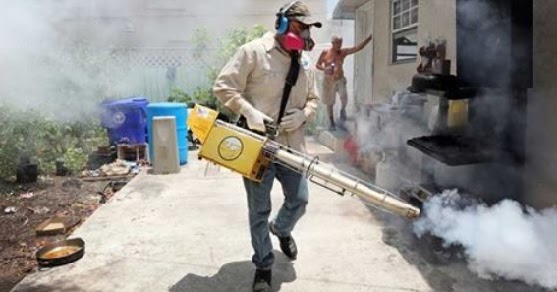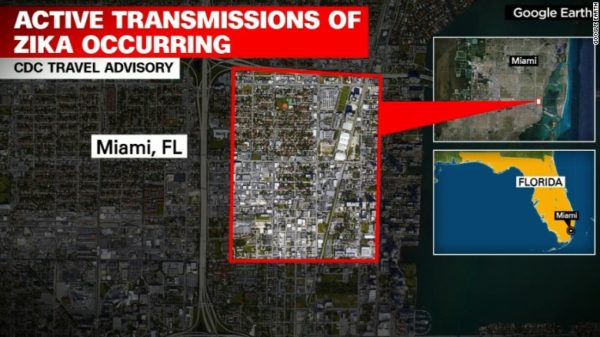
In late July 2016, the first local spread of the Zika virus via infected mosquitoes, was discovered and officially reported in the United States. This Zika case occurred in the state of Florida.
As of August 3rd 2016, the Centers for Disease Control and Prevention (CDC) estimates that there are 7,360 confirmed Zika cases in the United States. This includes 1,817 cases in the continental United States, and 5,526 cases in its territories of Puerto Rico, the Virgin Islands and American Samoa.
Particularly in the city of Miami, the CDC has issued an unprecedented travel warning, advising pregnant women and their partners not to travel to a small community just north of downtown Miami, where the Zika virus is said to be actively circulating. This makes the Zika situation in the state of Florida very serious. The state depends on tourism due to its diverse nature. Now, state officials fear the Zika alert could have a negative impact on the tourist sector. To save the situation, officials are looking for immediate measures to eradicate the virus from the state.
The Free Thought Project reports that in some areas of Florida, the potentially dangerous pesticide named naled is being sprayed to eradicate the Aedes aegypti mosquito, the suspected carrier of the zika virus.
On August 3rd 2016, airplanes began spraying naled aerosol over an approximately 10-square-mile section of Miami, centered over the neighborhood of Wynwood, where zika has reportedly been spreading; forcing the CDC to issue a travel warning to the area.
According to the Free Thought Project, naled is a potential neurotoxin substance that kills mosquitoes on contact. In Puerto Rico where the Zika virus has become a major concerned for authorities, it is said the naled compound was rejected by the Island’s officials to combat the Zika virus. Officials there reportedly raised concerns about safety of the compound. They have since opted to spray an organic larvicide, known as Bti. This decision not to use naled in Puerto Rico, was taken despite the recommendation by the United States Environmental Protection Agency (EPA) that the compound is perfectly safe.
According to a local CBS affiliate in Miami, to keep naled airborne where it would be most effective, it should be sprayed in very fine aerosol droplets. Just two tablespoons of the substance can be sprayed to cover an area equivalent of two football fields. This shows the powerful nature of the compound.
Even the Florida Department of Health admits that if greater amounts of naled is employed at a particular place, it could cause a person to salivate more, feel numbness, headaches, dizziness, tremors, nausea, abdominal cramps, sweating, blurred vision, difficulty breathing and a slowed heartbeat.
Again, according to toxicology encyclopedia, Toxipedia’s entry for naled:
“Nearly all of the naled used is applied aerially and drift from the application is considered a problem because naled is also toxic to beneficial insects (#Cox, 2002). Contamination has been found as far away as 750 meters from the site of application in a University of Florida study which led to the suggestion that no-spray buffer zones be established to greater than 750 meters from ‘economically sensitive areas’ (#Cox, 2002). Unfortunately the most toxic route of exposure is inhalation and the most common application is as a mist making inhalation the most likely route as well (#ATSDR, 2007).”
Toxipedia further exposes the EPA’s assertion that the compound is perfectly safe. Toxipedia states that the EPA itself classifies a component of naled as a possible carcinogen, due to mice developing lung tumors when exposed to the chemical.
Apart from the health concerns of the compound, some observers argue that spraying campaigns are ineffective in eradicating the mosquitoes carrying the disease. This is because the mosquitoes do not mostly live in the open. They live indoors or in small enclosed areas where spray wouldn’t necessarily reach.
A formal senior CDC official, Duane Gubler said: “Successful spraying against Aedes depends on too many factors. Do people have their windows open? What rate is the wind speed? What is the weather? Spraying doesn’t kill larvae, and naled isn’t a residual insecticide. You’d have to spray weekly to make an impact.”
The Miami Herald also added that aerial spraying is particularly not effective in eradicating the exact species of mosquito responsible for transmitting the zika virus, because the mosquitoes live and breed near or in covered structures, and near humans.
However, despite the safety and the effective concerns raised by observers, Mayor of Miami-Dade County, Carlos Gimenez said he does not have any objection because the compound has been recommended by the Federal and State governments.
“Some say it’s effective. Some say it’s not that effective. But it’s been recommended by the state and federal government and we’re going to do it. If it has a success rate of 10, 20, 30 percent, then that’s 30 percent more than what we had before,” mayor Gimenez was quoted as saying.
You want to support Anonymous Independent & Investigative News? Please, follow us on Twitter: Follow @AnonymousNewsHQ
This article (Alert: Florida Sprays Neurotoxic Pesticide Banned in Other Countries to Fight Zika) is a free and open source. You have permission to republish this article under a Creative Commons license with attribution to the author and AnonHQ.com.









Understandably spraying for mosquitoes isn’t so good however getting Zika or other diseases from them is terrible..the mosquito population in my province is unbelievable and going outside has become impossible…they have to be controlled somehow.